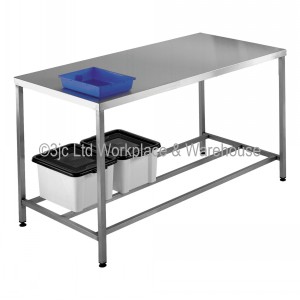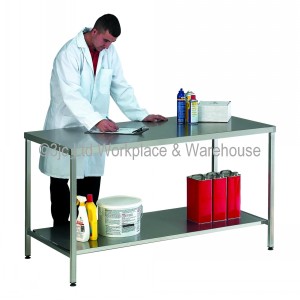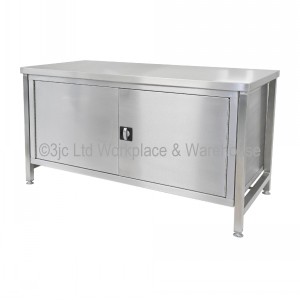A workbench is more than just a surface to work on. It is the heart of any lab, workshop, or industrial facility, where experiments, innovations, and discoveries are made. That is why choosing the right workbench is crucial for creating a safe, efficient, and productive workspace.
3JC Ltd, a leading supplier of storage and workplace equipment, knows this well and offers a range of workbenches to suit different needs and preferences.
Among them, Stainless Workbenches are particularly popular for laboratories, where hygiene and cleanliness are paramount. In this article, we will explain the benefits of Stainless Workbenches and why they are a ‘Hygiene Hero’ for any lab.
Understanding Stainless Steel Workbenches
Stainless steel workbenches, as the name suggests, are work tables constructed from stainless steel. Known for their durability, versatility, and hygienic properties, they are a popular choice across many industries.
Why Stainless Steel?
Stainless steel is famous for its remarkable toughness and longevity. Its ability to resist rust and stains, along with its low maintenance needs, make it a perfect material for workbenches.
The 3JC Ltd Range: Why You Need a Stainless Workbench in Your Lab
Whether you are conducting experiments, testing samples, or analysing data, you need a workbench that can handle the demands of your lab. A workbench that is durable, hygienic, and versatile. A workbench that is made of stainless steel.
At 3JC Ltd, we are proud to offer a range of stainless workbenches, each with its own features and benefits.
Our stainless workbenches come in different sizes, heights, and configurations, so you can find the one that fits your space and your workflow. Here are some of the options we offer:
- Stainless Steel Work Table: A simple and sleek work table with a removable worktop and adjustable levelling feet. Perfect for small spaces and basic tasks.
- Stainless Steel Work Table With Lower Shelf: A work table with an extra lower shelf for additional storage and organisation. Great for keeping your tools and supplies within reach.
- Stainless Steel Workbench With Full-Width Cupboard: A heavy-duty workbench with a full-width cupboard and a lockable door. Ideal for storing and securing your valuable equipment and materials.
Stainless Workbenches: Spotlight on Hygiene
When it comes to hygiene, stainless workbenches are a cut above the rest. They are particularly favoured in laboratories, food preparation areas, hospitals, and any environment where cleanliness is paramount.
‘Easy Clean’ Design
Stainless steel has a non-porous surface, meaning it does not absorb or retain substances. This characteristic makes it easy to clean and sanitise, preventing the build-up of bacteria or other harmful microorganisms.
Resistance to Corrosion
Stainless steel’s resistance to corrosion also contributes to its hygiene credentials. The material’s protective oxide layer prevents rust formation, ensuring the workbench maintains its clean, shiny appearance even after prolonged use.
Adjustable Features
Our stainless workbenches come with adjustable levelling feet, enabling them to stand firmly on uneven surfaces. This stability further enhances hygiene, as there is less chance of spillages or accidents.
Stainless Workbenches: The Strength Factor
A workbench needs to be more than just hygienic – it also needs to be strong and durable. Here’s how our Stainless Workbenches measure up.
Robust Construction
Our workbenches are manufactured from a heavy gauge of stainless steel, ensuring they can withstand heavy use without buckling or deforming.
High Weight Capacity
Thanks to their robust construction, our stainless workbenches can support substantial weight. Whether you’re completing light tasks or handling heavy equipment, these benches will always be there for you.
Long Lifespan
The durability of stainless steel translates to a long lifespan for our workbenches. They are designed to withstand the rigours of daily use, providing a reliable work surface for years to come.
Versatility and Flexibility: Adapting to Your Needs
Another key advantage of stainless workbenches is their versatility. They can be tailored to fit a variety of uses, making them a versatile option for different settings.
Customisation Options
At 3JC Ltd, we offer a range of stainless steel workbench accessories, including drawers, cupboards, and shelves. These can be added to your workbench to improve its functionality and customise it to your particular needs.
Wide Application
From laboratories and kitchens to workshops and hospitals, stainless workbenches serve a variety of settings. Their sleek, professional appearance, combined with their functional benefits, make them a valuable addition to any workspace.
Stainless Workbenches and Sustainability
In a world increasingly focused on sustainability, the choice of a stainless steel workbench is an environmentally conscious one.
Recyclability
Stainless steel is 100% recyclable, meaning old or damaged workbenches can be melted down and repurposed, reducing waste and conserving resources.
Longevity
The long lifespan of stainless workbenches also contributes to their eco-friendliness. By choosing a durable workbench, you minimise the need for frequent replacements, leading to less waste and lower consumption of materials and energy.
Conclusion
Whether you value hygiene, strength, versatility, or sustainability, there’s no denying the benefits of stainless workbenches. At 3JC Ltd, we are proud to offer a range of high-quality stainless steel workbenches designed to meet your needs.
Click here to discover our range and discover the perfect workbench for your workspace.
Stainless Workbenches: Your Questions Answered
1. What are the benefits of stainless workbenches?
Stainless workbenches are durable, hygienic, and versatile. They can withstand high temperatures, pressures, and chemicals without rusting, corroding, or warping. They are easy to clean and sanitise, making them ideal for laboratories, food preparation, hospitals, and other environments where hygiene is essential. They can also be customised and adapted to suit different needs and preferences by combining them with other materials or accessories.
2. How do you maintain and clean your stainless workbench?
Stainless workbenches are easy to maintain and clean, as they are resistant to stains, scratches, and bacteria. However, to keep them in optimal condition, you should follow some simple steps:
- Clean the surface with a damp cloth or sponge to eliminate any dirt, dust, or spills after each use.
- Use a gentle detergent, soap, and warm water to wash the surface completely. Avoid using harsh cleaners, scouring pads, or steel wool, as they can ruin the finish and cause scratches.
- Rinse the surface with clean water and wipe it with a soft cloth or towel to avoid water spots and streaks.
- Polish the surface with a stainless steel cleaner or polish to renew the shine and protect the metal. Follow the manufacturer’s instructions and safety precautions.
3. How do you install and assemble your stainless workbench?
Installing and assembling your stainless workbench is easy and fast, as it comes with all the necessary hardware and instructions. You will need some essential tools, such as a screwdriver, a wrench, and a level. Here are the general steps to follow:
- Unpack the workbench and check the contents. Make sure you have all the parts and accessories and that they are in good condition. If anything is missing or damaged, contact us immediately.
- Attach the legs to the worktop using the screws and washers provided. Make sure the legs are aligned and secure.
- Attach the lower shelf or the cupboard, if applicable, using the screws and washers provided. Make sure they are aligned and secure.
- Adjust the levelling feet, if needed, to ensure the workbench is stable and even. Use a level to check the balance.
- Enjoy your new stainless workbench!
4. How do you prevent scratches and dents on your stainless workbench?
Stainless workbenches are scratch-resistant and dent-resistant, but they are not scratch-proof or dent-proof. To prevent scratches and dents on your stainless workbench, you should follow some simple tips:
- Use a cutting board or a mat when using sharp tools or objects on the workbench surface. Do not cut or chop directly on the stainless steel.
- Avoid dragging or sliding heavy or abrasive items on the workbench surface. Lift and place them gently instead.
- Use soft or rubberised pads or coasters when placing hot or cold items on the workbench surface. Do not place them directly on the stainless steel.
- Wash the workbench surface often with a soft cloth or sponge and a gentle detergent or soap. Avoid abrasive cleaners, scouring pads, or steel wool, as they can damage the finish.
- Polish the workbench surface occasionally with a stainless steel cleaner or polish to remove minor scratches and restore shine.
5. How do you recycle or dispose of your old stainless workbench?
Stainless workbenches are durable and long-lasting, but they may eventually need to be replaced or upgraded. If you have an old stainless workbench that you no longer need or want, you can recycle or dispose of it in an environmentally friendly way. Here are some options:
- Sell or donate your old stainless workbench to someone who can use it. You can advertise it online, in local newspapers, or on community bulletin boards. You can also contact local charities, schools, or organisations that may need a workbench for their projects or activities.
- Take your old stainless steel workbench to a metal recycling facility. You can recycle stainless steel in any way you want. It can be broken down and used to make new things. You can look online or call your local trash management body to find a metal recycling centre near you. You could also get paid to get rid of your old metal.
- Dispose of your old stainless workbench at a landfill or a waste disposal site. If you cannot sell, donate, or recycle your old stainless workbench, you can dispose of it at a landfill or a waste disposal site. However, this should be your last resort, as more eco-friendly options exist. You should also check the regulations and fees of your local waste management authority before disposing of your old stainless workbench.




